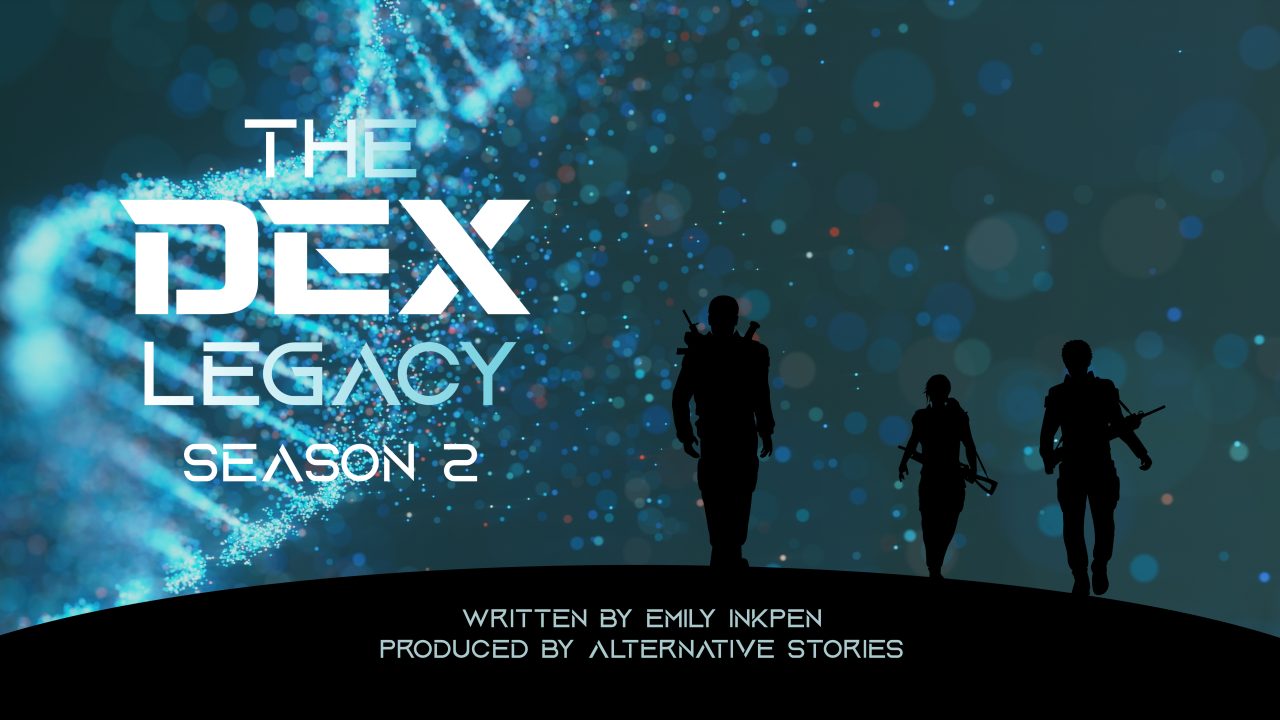Emily Inkpen talks us through the process of turning her sci-fi drama, The Dex Legacy, into a successful audio series, and funding Season Two via the crowdfunding platform Kickstarter.

Making money from creative projects can be an uphill struggle, especially for indie writers and producers. As getting our work out into the world inevitably takes a certain level of investment, these funds must be found in our own pockets, or through creative methods. As a science fiction and fantasy writer of novels and audio drama, I have plenty of experience with the former and some with the latter – and the latter is a challenge.
I work with Write On! Audio’s producer, Chris Gregory, on sci-fi audio drama, The Dex Legacy. Season one has been an incredibly successful indie project. We’ve had over 70,000 downloads around the world, we’re a top five per cent global podcast and we’ve just been signed with Apollo Podcasts as part of their premium offering. Following this success, we’ve embarked upon the creation of season two, which will bring a new set of financial challenges. Season one was recorded throughout the Covid pandemic and lockdowns, so we recorded asynchronously and covered actor fees ourselves. Now, we want to step up our production and studio time is expensive!
Why Crowdfund?
As long as it’s spent well, having a budget means quality. If you can get some capital behind you, you can get artists, composers, professional actors, advertising. This means more options for you as a creator, and often a better-quality product for the consumer.
The Platforms
There’s more than one way to crowdfund. Creators can do a short intense funding campaign, or set up ongoing communities of contributors who pay a small amount every month. Platforms such as Patreon are great for this, but for the sake of this article, we’ll focus on the short intense funding push.
Let’s start with perhaps the best-known platform, Kickstarter. Kickstarter claims to give fundraisers the best chance of reaching their target. The volume of traffic to the site is unprecedented, with people browsing projects looking for products to back. However, the brand does come with an element of jeopardy. Projects that fail to reach their target within their chosen timescale receive no funding at all. It’s all or nothing.
There are ways around this. For instance, most creators set a low initial target, with ‘stretch goals’. With ours, we set the target of £3,500. This will in no way cover all the costs of producing the show; for that we’re looking at much more, but our goal will cover studio and actor fees, which is a huge chunk we don’t have to find ourselves. Our stretch goals include ‘covering all basic costs’, ‘covering extra production costs’, and ‘actor bonuses’.
Other platforms include Indiegogo, GoFundMe, Crowdfunder, Ko-fi – a hybrid platform allowing one-off fundraising efforts alongside ongoing monthly support, and the ability for backers to make small one-off donations.
Every platform is different. Check them out and see the type of projects they support.
The Planning Phase
The best thing to do is look at projects like yours that have seen success. Look at what they’ve done. Look at their updates and comments and take on board those learnings.
Preparing your page or ‘story’ is key. It’s not only about the words, it’s about the visuals, too. You’ll need a video. People respond well to hearing from the creator. Most people don’t read blocks of text on websites. You need to break your information into bite-size chunks and do something visual to refresh the reader’s brain between sections. For The Dex Legacy I created visually strong subtitles, a visual depiction of our reviews, and a tiled image of our actors, so backers can put faces to the names.
This is not the time to be modest. Get the statistics out. Show off the awards and accolades. If you’re a writer who won an award for a short story and you’re crowdfunding for audio, include the award, because that endorsement of skill will set you apart from others.
Always remember, your backers are investing in your project and you need to take them seriously. Rewards are there to show appreciation and you’ll need to think about each one. Backers do read the list of benefits and some will dig a little deeper if they see cool add-ons in the next tier. An added benefit of sending out bonuses is that your backers will have a physical reminder of the project they helped bring to life. If they’re putting their cup of tea down on a branded coaster every day, that’s a daily reminder of your project. Simple. Effective. Heartfelt.
Pre-Launch
Whether you can do a big pre-launch push is dependent on your platform, but I would advise waiting until you have a preview page before you start. Everything you do around a crowdfunder should come with a direct call to action (CTA). When your preview page goes live, people can follow the project, so starting with a, ‘We’re preparing our crowdfunder, follow the project on the platform and you’ll be the first to know when it goes live’ is much stronger than, ‘We’re preparing a crowd funder… we’ll let you know.’
For your own sanity, put feelers out to friends and family and try to firm-up some early donations. Getting away from £0 fast is important. Nobody wants to back a loser, so show instant interest and you’re halfway to convincing people you’re worth backing. People love a bandwagon, so get yours to the starting line before the whistle blows!
Launch
Try to launch on a Monday or Tuesday, and try to close on a Thursday. Those are the sweet-spots for maximum traffic and interest. The most significant momentum you can build around your project occurs in the first and last 48 hours. People love to jump in early, and the rest like a deadline!
Prepare For The Ride
The fun caveat here is that nothing prepares you for the ride.
If you’re invested in your crowdfunder, it will take on a life of its own. Trust me when I say the refresh button will never have such an intense workout.
This is the phase where you see the results of your tiers. If everyone is going for one over another, perhaps you need to consider adding something to the other to make it more enticing. And make sure you shout about it when you do. People can always increase their donations. Of course, if one of your tiers is £1000, you may not see many investing at that level, and that’s OK too. Dream big!
The Long Road
Donations will ebb and flow. The initial madness will die down, and that’s OK, because you have a month of this to get through. Thank backers, reply to messages, provide updates, and line up some mentions. If you have friends with newsletters, now is the time to flex some favours. If you’re aware of other podcasts, reach out. If you know publications like Write On! who want articles… you get the idea. Prepare to work for your money. Make things, write things, and put yourself out there in the most un-British ways imaginable.
The most amazing result of this act of reaching into the world is the nurturing of a new and strong fanbase. Through this process, we’re connecting with people in different ways, creating levels of engagement hitherto unimagined. It’s terrifying and wonderful.
Closing The Campaign
Chris and I are constantly coming up with ideas for ways to keep people engaged. If nothing else, crowdfunding really does focus the mind. Towards the end, you’ll want to introduce a new donation tier and add-ons. These re-engage people who have looked and not backed, as well as those who have backed and are interested to see what else is on offer. It could mean increased donations.
*
UPDATE: The Dex Legacy Campaign - Fully Funded
Our campaign went very well. We were 25 percent funded within 24 hours, reached 50 per cent the next day and, at the time of writing this article one week in, were at 75. I updated people daily on our social channels, offered new benefits, launched cover reveals and actor videos, where our cast talked about how important studio recording is. It was an intense few weeks, but worth it in the end. We secured over 135% of our goal, surpassing our first stretch goal, and we are now finalising studio dates.
The Dex Legacy Kickstarter campaign closed on June 7th, surpassing their fundraising goal and their first stretch goal. Season 2 is now in production.
You can still follow our Kickstarter page (https://www.kickstarter.com/projects/emilyinkpen/the-dex-legacy-science-fiction-audio-drama-season-2) for updates on the production and shipping of pledge prizes. We’re working so hard and we have so far to go, but Season Two is finally happening and we couldn't be more excited.
You can listen to Season One of The Dex Legacy by searching 'The Dex Legacy' in your favourite podcast app and listen or find out more by visiting our website: www.thedexlegacy.com/

This article was originally published on pentoprint.org
More about Emily Inkpen
Born in South London and raised on the South Coast of England, Emily moved to Glasgow for her university years and has finally settled in Berkshire. On a daily basis, Emily juggles copywriting for Marmalade Game Studio with writing novels, short stories and audio drama, while acting as Social Media Officer for the BSFA.
With a background in medical writing and copywriting for healthtech, the scientific influences that feed into Emily's work tend to be on the biological side. Her trilogy of novels (the first of which is repped by the John Jarrold Literary Agency and in publisher submission) and prequel audio drama series fall under the title of The Dex Legacy. The series tells the story of three biologically enhanced children owned and raised by megalomaniacal weapons manufacturer turned head of state, Nathaniel Dex.
For more information about The Dex Legacy, visit www.thedexlegacy.com, and also follow on Twitter @thedexlegacy, and Instagram @thedexlegacy1
For more about Emily, visit www.emilyinkpen.com, and follow her on Twitter @emilyinkpen
Comments